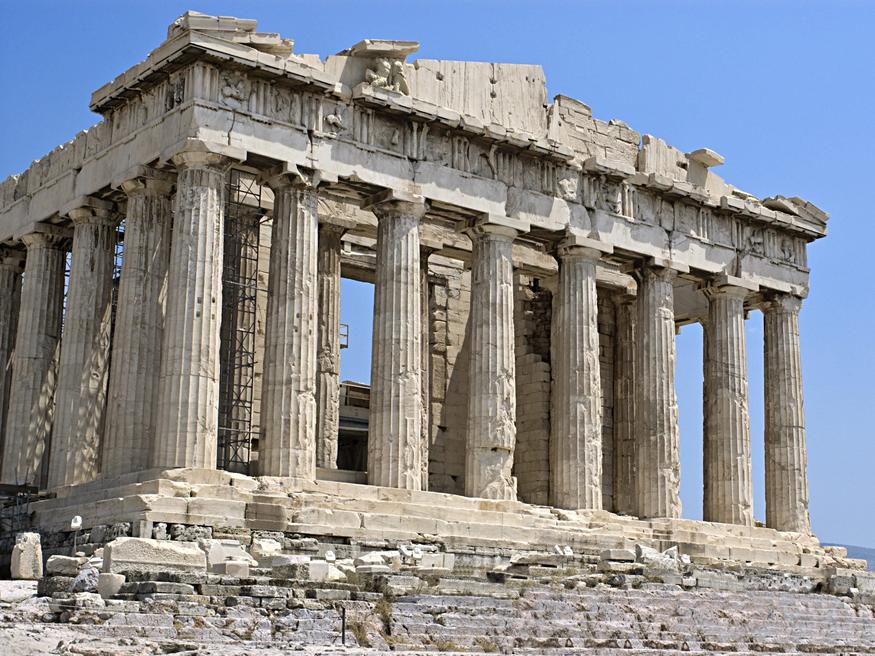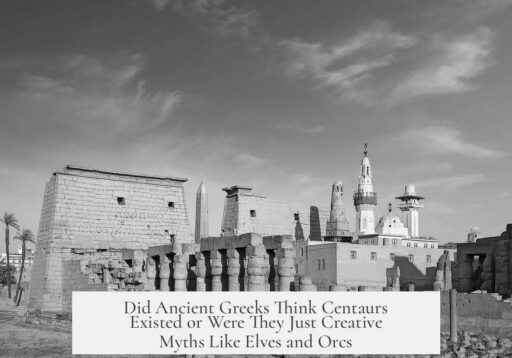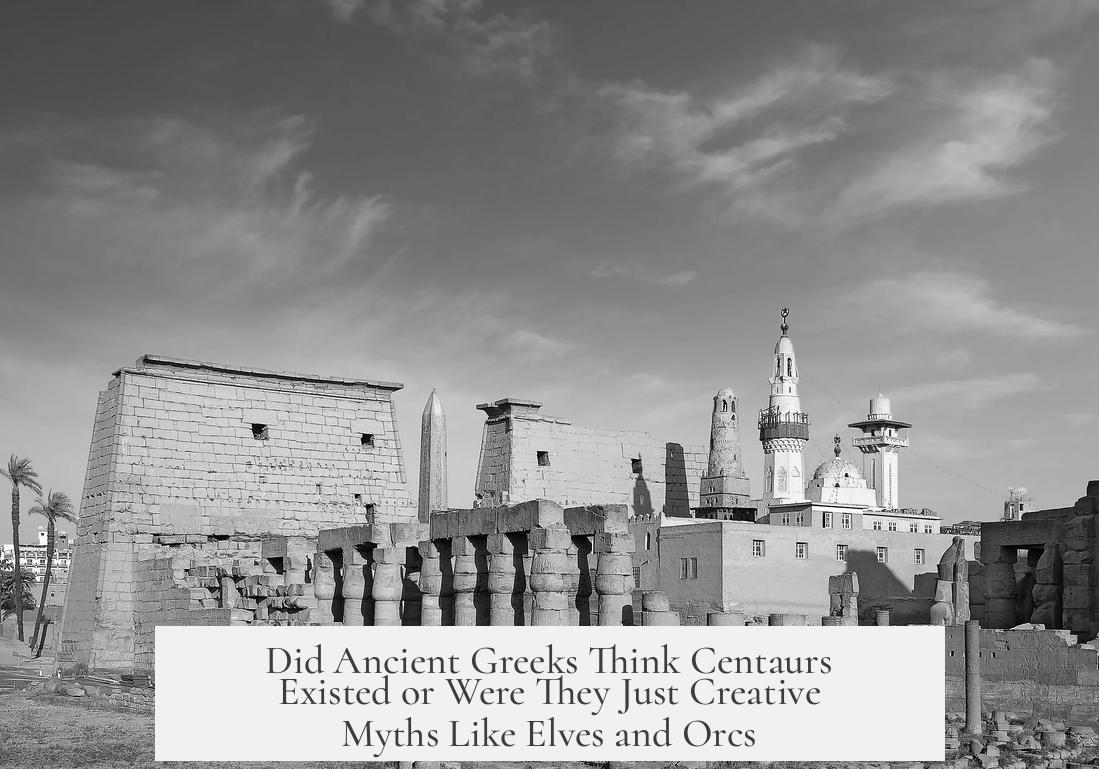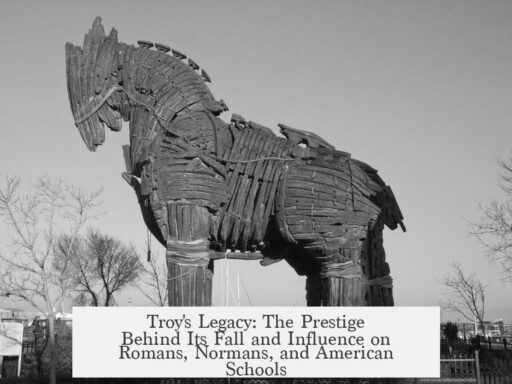The ancient Greeks held varied views on the existence of centaurs. Many among the general public accepted centaurs as real creatures, believing they lived in a distant, mythic age separated from the current world. However, scholars and philosophers often regarded centaurs as mythological symbols or narrative devices rather than literal beings.

Greek mythology places centaurs in a remote past, known as the Age of Heroes. This era was thought to be long gone, populated by extraordinary creatures and heroes not existing in the present. Most common Greeks treated stories of centaurs like historical accounts of a bygone time, blending belief and legend without strict boundaries.
Philosophers and historians often took a different approach. They tended to interpret centaur myths allegorically or skeptically. For example, the Roman poet and Epicurean philosopher Lucretius firmly denied that centaurs ever physically existed. He argued that creatures composed of both human and horse parts were biologically impossible. This denial aligns with a broader trend among intellectuals who separated myth from reality.

Paul Veyne, a modern historian, explains that many Greek thinkers did not believe in the literal existence of gods or hybrid monsters like centaurs. Instead, they saw myths as holding some narrative truth, embellished by superstition. Mythical figures existed in a “higher, purer” realm, not the mundane world. In contrast, the general public accepted such creatures at face value.
The myth of the Centauromachy—the battle between centaurs and the Lapiths—illustrates the symbolic role centaurs played in Greek culture. Centaurs represented forces of barbarism and chaos, contrasting with the order and civility of Greek city-states. This allegory gained political resonance, especially after the Persian Wars, and was artistically celebrated in the Parthenon sculptures. At the same time, the centaur Chiron stood apart as a wise, civilized figure, tutoring great heroes like Achilles. This contrast highlights the range of symbolic meanings centaurs carried.

The belief in centaurs was not uniform. Skeptics such as Thucydides likely dismissed their physical existence, while others, including notable leaders like Alexander the Great, may have regarded centaurs—especially Chiron—as part of heroic tradition. Plutarch recounts that Alexander visited the tomb of Achilles, supposedly raised by the centaur Chiron, showing respect for mythical heritage. However, such reports appear long after the Classical period and warrant caution.
Various origins for the centaur myth exist. Some scholars suggest encounters with nomadic tribes like the Scythians inspired notions of half-human, half-animal beings. Mythical constructs like the Egyptian sphinx or Cretan bull worship also influenced these images. Philosophers like Empedocles poetically described centaurs and similar creatures as “lost species,” blending myth with early proto-scientific ideas.

| Group | Belief About Centaurs |
|---|---|
| General Public | Accepted centaurs as real but in a distant mythic past. |
| Philosophers & Historians | Skeptical of literal existence; viewed centaurs as myth or symbolic. |
| Political & Cultural Leaders | Used centaur myths symbolically; some (e.g., Alexander) may have revered them in heroic context. |
Greek myths, including those about centaurs, blended fictional narrative and perceived truth fluidly. Unlike modern fantasy creatures such as elves or orcs—clearly fictional—ancient Greek belief often placed these beings in alternate realities or past ages. Myth served cultural, moral, and political purposes beyond mere storytelling.
- Centaurs were largely symbolic, representing barbarism versus civilization.
- Most Greeks accepted centaurs as part of a mythic past, not present reality.
- Philosophers rejected their literal existence on logical and biological grounds.
- Myths contained kernels of truth but were embellished and interpreted variably.
- Some elite figures revered centaurs in heroic or religious context.
Did the Ancient Greeks Believe Centaurs Actually Existed, or Were Centaurs Merely Narrative Elements the Way We Use Elves and Orcs Today?

The short answer: Ancient Greeks generally did not believe centaurs literally roamed the earth like some half-horse, half-human neighbors over the fence. Instead, centaurs inhabited a mythical past or symbolic realm—much like elves and orcs in modern fantasy tales. Many treated them as metaphors or legendary figures, not as factual creatures.
Let’s trot through the evidence and unpack how and why the centaur myth galloped through Greek culture—sometimes as belief, often as allegory.

Mythical Creatures: Real-ish but in Another Realm?
Most Greeks thought mythical beings such as centaurs, heroes, and monsters weren’t part of the everyday world. Think of them as relics from an ancient, purer age—the Mythic or Heroic Age. For example, the Age of Heroes, marked by figures like Orestes (son of Agamemnon), was believed to be far behind them, around 1100 BCE. This past realm felt distant and mysterious, where centaurs mingled with men yet did not cross into their present reality.
The public largely accepted these beings as “real” in their stories and experiences of culture but not as physical entities right outside their doorsteps. These tales offered meaning, identity, and explanations without demanding literal belief like modern fantasy fans suspend disbelief.
Philosophers Took the Logical Saddle
While many accepted the mythic world with an uncritical soft spot, philosophers and historians often raised skeptical eyebrows. Lucretius, a Roman poet and philosopher echoing Greek rational traditions, bluntly rejected the literal existence of centaurs on practical grounds. He reasoned:
“But Centaurs never existed at all, nor at any time can creatures with a double nature and two-fold body exist composed of unlike sorts of limbs… you don’t by chance believe that Centaurs can be put together or made from a human and the seed of burden-bearing horses…”
Lucretius’ biological logic went something like this: horses and humans mature differently; a half-horse, half-human hybrid just doesn’t add up. Not exactly a creature fit for a biology textbook.
Philosophers often assumed myths contained kernels of truth embedded in popular stories but distorted by imagination and oral tradition. Aristotle interpreted the minotaur legend as a convoluted retelling of an actual human kidnapping, showing how myth and history mingled.
Centaurs: Symbolism Galloping Front and Center
One of the most telling signs that centaurs were less thought of as real creatures and more as symbols lies in the Centauromachy myth. This story depicts centaurs crashing a wedding, getting drunk, and causing chaos.
Pirithoos, king of the Lapiths, is marrying Hippodamia. Centaurs are guests but become unruly, grope female guests, and engage in a fierce battle with the Lapiths and hero Theseus.
This clash was no mere party gone wrong; it symbolized the struggle between civilized order and barbaric chaos, a recurring theme echoed in battles between gods and titans or Greeks and Amazons.
The theme resonated politically too. After the Persian Wars (480–479 BCE), the Greek city-states emphasized the triumph of order over barbarism. Artisans immortalized the Centauromachy on the Parthenon metopes, blending mythology and political messaging. So here, centaurs stood for wildness threatening the civilized polis rather than genuine fauna.
A Tale of Two Centaurs: Wise Chiron vs. Rowdy Rest
Not all centaurs wore the same pants—or hooves. Chiron stood apart from his wild brethren. He was a wise teacher, tutor to heroes like Achilles, and portrayed as thoughtful and kind.
His origin story is fascinating: some myths fuse Chiron with foreign deities and legendary wise men. Chiron may represent an idealization of knowledge and order, contrasting with the typical portrayals of centaurs as drunken, violent, and crude.
This duality in centaur myths suggests nuanced storytelling rather than straightforward animal sightings. The Greeks could comfortably accept Chiron’s existence in a mythic or symbolic sense without believing in the rowdy pack roaming the mountains.
Greeks’ Geographic and Social Beliefs Varied
Belief in centaurs wasn’t uniform. Regional differences, class attitudes, and exposure to philosophical ideas meant some Greeks accepted the myths more literally than others. The historian Thucydides, known for his critical eye, clearly doubted such tales.
Meanwhile, in Athens, where culture and politics intertwined tightly, centaurs often appeared more as dramatic symbols than as objects of belief. The famous Parthenon sculptures reflect this Athenian worldview—celebrating order’s victory over chaos for political reasons.
Could Alexander the Great Have Believed in Centaurs?
A tantalizing detail is the late report from Plutarch that Alexander the Great believed in his heroic ancestry, including that Achilles was reared by the centaur Chiron. This suggests some elite Greeks might have entertained or respected mythic traditions in semi-serious ways.
But note Plutarch wrote centuries later and mixed history with legend, so treat this tale like a cocktail—enjoyable but possibly spiked.
Origins and Influences Behind the Centaur Myth
The persistent centaur figure likely emerged from multiple sources:
- Greek encounters with nomadic steppe peoples such as the Scythians, who seemed wild and foreign, spurring anthropomorphic images of half-human, half-animal savagery.
- Borrowings from Egyptian mythology, including the sphinx and other mixed creatures.
- Religious ideas like Orphism, promoting connections between souls and animals.
- Fossil discoveries, speculative imagination, and poetic interpretations describing mythical creatures as evolutionary “aberrations,” as Empedocles noted.
These influences reflect a world eager to explain strange finds, fears, and cultural encounters through captivating stories.
How Does This Compare to Our Modern Usage of Elves and Orcs?
Today’s fantasy creatures like elves and orcs fill a mythical role analogous to ancient centaurs. They’re narrative devices used to explore themes like nature vs. civilization, good vs. evil, or heroism vs. chaos. Few expect literal existence today—fantasy fans accept them as storytelling tools.
Similarly, the Greeks mingled belief and allegory. For many, centaurs were part of a world where history, religion, and storytelling blended without sharp lines. They weren’t an ancient version of “believers” in mythical creatures; rather, they engaged with these myths as layers of meaning and tradition.
Summary: A Galloping Conclusion
- Popular Belief: Centaurs lived in a sacred, mythic past unrelated to everyday reality.
- Philosophers’ View: Rational thinkers rejected the physical existence of mythical hybrids, treating myths as distorted narratives with kernels of truth.
- Symbolism: Centaurs represented the wild, uncivilized, and chaotic forces opposing Greek order and law.
- Varied Beliefs: Acceptance of centaurs ranged widely depending on geography, class, and time.
- Legacy: Centaurs continue as powerful narrative elements, much like modern fantasy creatures.
So next time you picture a centaur, remember: the ancient Greeks didn’t exactly chase them down the street, but they certainly ran wild in the realms of myth, symbol, and culture.




